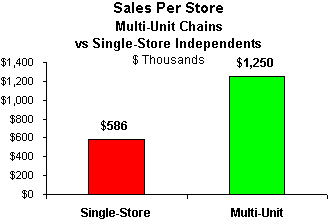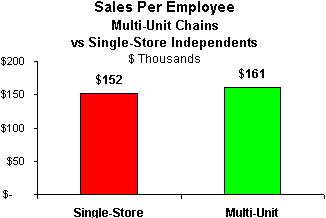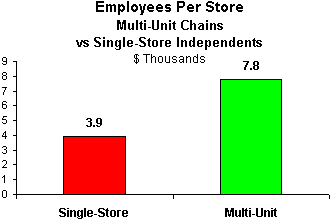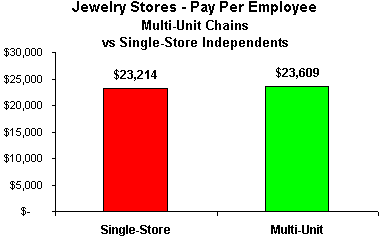IDEX Online Research: More Employees Might Help Independent Jewelers
May 10, 06
At one time or another, every jeweler has concluded that if he or she could increase their sales per store markedly, their profit worries would be solved. The logic is simple: there are certain relatively fixed costs, such as the manager’s salary, base rent, utilities, and property taxes. If sales per store increase, these costs do not escalate proportionally. Thus, every incremental dollar of sales, after paying for the merchandise and sales expenses, falls to the bottom line – the profit line.
Shrinking Employment Hampers Sales Growth
According to the Department of Commerce’s latest Business Census data, the typical chain jewelry store generates about $1,250,000 in annual sales per unit while the typical single-store independent jeweler generates only $586,000 per store in sales. IDEX Online Research notes that these numbers do not match those from Jewelers of America, but the trend is parallel. Single-store operators’ sales per store are less than half the typical sales per store of a multi-unit chain, as the graph below illustrates.
 Source: US Dept of Commerce |
Many independent jewelers claim that the reason chain stores generate such high sales productivity is that chain employees can focus totally on selling merchandise to customers. Overhead-related functions such as buying and management are handled centrally in a chain operation, a luxury that independent single-store owner/operator jewelers do not have.
However, based on data from the Business Census, which tabulated responses from just over 75 percent of all the specialty jewelers in the U.S., sales per employee in chain stores are nearly identical to sales per employee of independent single-store operations. Data from Jewelers of America’s Cost of Doing Business Survey corroborate these findings. The graph below summarizes these sales per employee for single-store jewelers versus multi-store chains.

Source: US Dept of Commerce
Major Variable Is Employees per Store
If sales per employee are nearly identical when comparing single-store independents to multi-store chains, but sales per store are more than double for the multi-store operations versus the single-unit operators, is there a variable that explains this dichotomy?
The latest government data shows that when comparing single-store operations to chain store jewelers there is a wide variation is the number of employees per store.
In chain stores, there are nearly eight employees per store. In contrast, independent single-store jewelers typically operate with about half that number of employees per unit, or about four people (full-time equivalents) per store. The graph below illustrates this finding.
 Source: US Dept of Commerce |
The Simplistic Conclusion: Hire More Sales People
It may be simplistic to suggest that there is only one extremely powerful variable that affects sales per store. The reality is that store sales performance is the result of a complex combination of variables. However, the correlation between sales levels and some variables is much greater than the correlation of sales with other variables.
In the case of U.S. jewelers, there is an extremely high correlation between sales per store and the number of sales employees in that store.
However, the simplistic conclusion for single-store operators is this: hire more sales people, if you want to build your sales. And, quite frankly, this is a viable solution.
However, most independent specialty jewelers are owner-operator affairs where the owners have extensive knowledge about gemstones, precious metals, and jewelry, but have very little knowledge about human resources functions such as hiring, training, and firing employees.
Further, most independent specialty jewelers are family operations where they have worked for life, with little turnover among family members. In contrast, those jewelers often complain about the high turnover of non-family employees. That is no surprise: family and non-family employees usually mix like oil and water.
Other Variables Don’t Matter Much In Store Sales Productivity
IDEX Online Research studied other factors that could logically affect store sales productivity, but found correlation levels to be very low.
For example, store square footage of the typical jewelry store (with a range of 800 to 1,500 square feet) has virtually no correlation with sales per store. Multi-store chains generate sales per store twice the sales level of single-store operators, even though the multi-unit chain stores are about 1/3 smaller. A mathematician looking at this comparison could conclude that sales volume might be inversely related to store square footage. IDEX Online Research has long advocated that most single-unit operators have far too much square footage in their stores.
The amount of merchandise in the store also has little to do with that store’s sales volume. In fact, too much merchandise can be detrimental. Sales people cannot remember what they have in inventory, and customers complain that they are confused by too much product.
Further, employee pay scales do not seem to differ much between single-store operators and multi-store chains, according to the U.S. Bureau of Labor Statistics. Many independent jewelers claim that the chain stores can pay better wages because they have economies of scale that allow them to pay better. IDEX Online Research has heard a similar argument from chains who allege that independent jewelers do not use logic when paying their employees, and thus inadvertently (or perhaps by design) are driving up the pay scale for retail sales people.
Either way, pay per employee among jewelers does not seem to differ much between chain stores and single-unit operators. Thus, it is not possible to tie per-store sales productivity to the pay scale of a jeweler. The following graph illustrates these findings.
 Source: US Dept of Commerce |